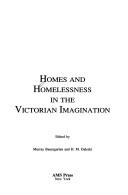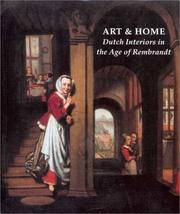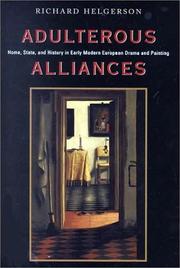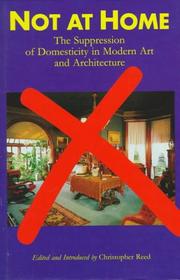| Listing 1 - 10 of 15 | << page >> |
Sort by
|
Book
ISBN: 0857738682 1780762011 0755693841 1501359851 1786739984 9781786739988 9781501359866 150135986X 9781501359859 9780857738684 9781780762012 9780755693849 Year: 2019 Publisher: London
Abstract | Keywords | Export | Availability | Bookmark
 Loading...
Loading...Choose an application
- Reference Manager
- EndNote
- RefWorks (Direct export to RefWorks)
"Our homes contain us, but they are also within us. They can represent places to be ourselves, to recollect childhood memories, or to withdraw into adult spaces of intimacy; they can be sites for developing rituals, family relationships, and acting out cultural expectations. Like the personal, social, and cultural elements out of which they are constructed, homes can be not only comforting, but threatening too. The home is a rich theme running through post-war western art, and it continues to engage contemporary artists today - yet it has been the subject of relatively little critical writing. Art and the Home: Comfort, Alienation and the Everyday is the first single-authored, up-to-date book on the subject. Imogen Racz provides a theme-led discussion about how the physical experience of the dwelling space and the psychological complexities of the domestic are manifested in art, focusing mainly on sculpture, installation and object-based practice; discussing the work and ideas of artists as diverse as Louise Bourgeois, Gordon Matta-Clark, George Segal and Cornelia Parker within their artistic and cultural contexts."--Wheelers.co.nz.
Book
ISBN: 9780228013730 0228013739 0228004101 9780228004103 Year: 2021 Publisher: Montreal Kingston London Chicago
Abstract | Keywords | Export | Availability | Bookmark
 Loading...
Loading...Choose an application
- Reference Manager
- EndNote
- RefWorks (Direct export to RefWorks)
From sleeping and bathing, chores, and making and eating food to the arrival of television, this book unveils the untold story of Italian domestic experiences from the 1940s to the 1970s, providing a fresh account of modern domesticity relevant to understanding how we make sense of the places we live.
Home in art. --- Art, Italian --- Families in art.

ISBN: 0404643523 Year: 1998 Publisher: New York AMS Press
Abstract | Keywords | Export | Availability | Bookmark
 Loading...
Loading...Choose an application
- Reference Manager
- EndNote
- RefWorks (Direct export to RefWorks)
Home in literature --- Homeless persons in art --- Dwellings in literature --- Home in art --- Homeless persons in art. --- Home in art.
Book
ISBN: 1350203092 1350203076 9781350203082 1350203084 9781350203075 9781350203068 9781350203099 Year: 2020 Publisher: London ; [London, England] : Bloomsbury Visual Arts, Bloomsbury Publishing,
Abstract | Keywords | Export | Availability | Bookmark
 Loading...
Loading...Choose an application
- Reference Manager
- EndNote
- RefWorks (Direct export to RefWorks)
"Art, Borders and Belonging: On Home and Migration investigates how three associated concepts-house, home and homeland-are represented in contemporary global art. The volume brings together essays which explore the conditions of global migration as a process that is always both about departures and homecomings, indeed, home-makings, through which the construction of migratory narratives are made possible. Although centrally concerned with how recent and contemporary works of art can materialize the migratory experience of movement and (re)settlement, the contributions to this book also explore how curating and exhibition practices, at both local and global levels, can extend and challenge conventional narratives of art, borders and belonging. A growing number of artists migrate; some for better job opportunities and for the experience of different cultures, others not by choice but as a consequence of forced displacement caused economic or environmental collapse, or by political, religious or military destabilization. In recent years, the theme of migration has emerged as a dominant subject in art and curatorial practices. Art, Borders and Belonging thus seeks to explore how the migratory experience is generated and displayed through the lens of contemporary art. In considering the extent to which the visual arts are intertwined with real life events, this text acts as a vehicle of knowledge transfer of cultural perspectives and enhances the importance of understanding artistic interventions in relation to home, migration and belonging"--
Art and society --- Belonging (Social psychology) in art. --- Dwellings in art. --- Home in art. --- Homeland in art. --- History


ISBN: 9040095876 Year: 2001 Publisher: Zwolle Waanders Publishers
Abstract | Keywords | Export | Availability | Bookmark
 Loading...
Loading...Choose an application
- Reference Manager
- EndNote
- RefWorks (Direct export to RefWorks)
Painting --- anno 1600-1699 --- Netherlands --- Home in art --- Manners and customs in art --- Painting, Dutch --- Exhibitions --- Painting [Dutch ] --- 17th century --- Interior decoration in art --- History
Book
ISBN: 1472539419 9781472539410 9781847889317 184788931X 9781847889324 1847889328 9781847889331 1847889336 9781474294072 1474294073 Year: 2013 Publisher: London ; London : Bloomsbury, Bloomsbury Publishing,
Abstract | Keywords | Export | Availability | Bookmark
 Loading...
Loading...Choose an application
- Reference Manager
- EndNote
- RefWorks (Direct export to RefWorks)
"In the act of enclosing space and making rooms, we make and define our aspirations and identities. Taking a room by room approach, this fascinating volume explores how representations of domestic space have embodied changing spatial configurations and values, and considers how we see modern individuals in the process of making themselves 'at home'. Scholars from the US, UK and Australasia re-visit and re-think interiors by Bonnard, Matisse, Degas and Vuillard, as well as the great spaces of early modernity; the drawing room in Rossetti's house, hallways in Hampstead Garden Suburb, the Paris attic of the Brothers Goncourt; Schutte-Lihotzky's Frankfurt Kitchen, to explore how interior making has changed from the Victorian to the modern period. From the smallest room - the bathroom - to the spacious verandas of Singapore Deco, Domestic Interiors focuses on modern rooms 'imaged' and imagined, it builds a distinct body of knowledge around the interior, interiority, representation and modernity, and creates a rich resource for students and scholars in art, architecture and design history."--Publisher's description.
Home in art. --- Rooms in art. --- Architecture and society --- Architecture --- Architecture and sociology --- Society and architecture --- Sociology and architecture --- History --- Social aspects --- Human factors
Book
ISBN: 9781847889317 9781847889324 9781847889331 184788931X 1847889328 1847889336 Year: 2013 Publisher: London Bloomsbury
Abstract | Keywords | Export | Availability | Bookmark
 Loading...
Loading...Choose an application
- Reference Manager
- EndNote
- RefWorks (Direct export to RefWorks)
"In the act of enclosing space and making rooms, we make and define our aspirations and identities. Taking a room by room approach, this fascinating volume explores how representations of domestic space have embodied changing spatial configurations and values, and considers how we see modern individuals in the process of making themselves 'at home'. Scholars from the US, UK and Australasia re-visit and re-think interiors by Bonnard, Matisse, Degas and Vuillard, as well as the great spaces of early modernity; the drawing room in Rossetti's house, hallways in Hampstead Garden Suburb, the Paris attic of the Brothers Goncourt; Schutte-Lihotzky's Frankfurt Kitchen, to explore how interior making has changed from the Victorian to the modern period. From the smallest room - the bathroom - to the spacious verandas of Singapore Deco, Domestic Interiors focuses on modern rooms 'imaged' and imagined, it builds a distinct body of knowledge around the interior, interiority, representation and modernity, and creates a rich resource for students and scholars in art, architecture and design history."--Publisher's description.
architectuur --- Private houses --- interior design --- architecture [discipline] --- binnenhuisinrichting --- anno 1800-1999 --- Architecture and society --- Architecture and society. --- Home in art. --- Rooms in art. --- History --- 1800-1999. --- Home in art --- Rooms in art --- Architecture --- Architecture and sociology --- Society and architecture --- Sociology and architecture --- Social aspects --- Human factors

ISBN: 0226326241 Year: 2000 Publisher: Chicago (Ill.) : University of Chicago press,
Abstract | Keywords | Export | Availability | Bookmark
 Loading...
Loading...Choose an application
- Reference Manager
- EndNote
- RefWorks (Direct export to RefWorks)
In a study that stretches over two centuries and four countries, Helgerson unearths the shared preoccupations of European domestic drama and painting. The result is an unexpected prehistory of the nineteenth- and twentieth-century cult of domesticity. [publisher's description]
Painting --- Drama --- History of civilization --- anno 1700-1799 --- anno 1600-1699 --- Europe --- Adultery in art. --- Home in art. --- Middle class in art. --- Painting, Dutch --- Painting, French --- Working class in art. --- Adultery in art --- Home in art --- Middle class in art --- Working class in art --- Labor and laboring classes in art

ISBN: 0500016925 Year: 1996 Publisher: New York, N.Y. Thames and Hudson
Abstract | Keywords | Export | Availability | Bookmark
 Loading...
Loading...Choose an application
- Reference Manager
- EndNote
- RefWorks (Direct export to RefWorks)
architectuur --- Sociology of the family. Sociology of sexuality --- moderne kunst --- gezinssociologie --- Modern [styles and periods] --- interior design --- Architecture --- Housekeeping --- Sociology of environment --- architecture [discipline] --- Art --- binnenhuisinrichting --- anno 1800-1999 --- Kunsttheorie ; architectuurtheorie ; onderdrukking van huiselijkheid --- 7.01 --- 72.01 --- Kunst ; theorie, filosofie, esthetica --- Architectuur ; theorie, filosofie, esthetica --- Architecture, Modern. --- Art, Modern. --- Families in art. --- Home in art. --- Modern [style or period] --- Art, Modern --- Architecture, Modern --- Families in art --- Home in art --- Family in art --- Modern art --- Modern architecture --- Nieuwe Ploeg (Group of artists) --- architectuurtheorie
Book
ISBN: 9780300214864 9780865592803 0300214863 0865592802 Year: 2016 Publisher: Chicago Art Institute of Chicago
Abstract | Keywords | Export | Availability | Bookmark
 Loading...
Loading...Choose an application
- Reference Manager
- EndNote
- RefWorks (Direct export to RefWorks)
"Over the course of his life, Van Gogh lived in thirty-seven different homes. In 1888 the artist moved into the only place he considered his own: his beloved "Yellow House" in Arles, France. His second-floor bedroom became a sanctuary, and it inspired him to record it in paint. Van Gogh so prized The Bedroom, which he deemed one of his best canvases, that he created two similar but distinct versions of it almost a year later, after being forced to leave his Yellow House following a nervous breakdown. In this reunion at the Art Institute of Chicago, the public has the extraordinary opportunity to see these three paintings hanging together as they did in Van Gogh's asylum studio. Presented only in Chicago, Van Gogh's Bedrooms is a momentous occasion that, along with this accompanying catalogue, sheds new light on these iconic compositions and the circumstances of their making. The exhibition is groundbreaking also because it is the first to consider the theme of home in the artist's work"...
ART / Individual Artists / Monographs / bisacsh --- ART / History / Modern (late 19th Century to 1945) / bisacsh --- ART / Collections, Catalogs, Exhibitions / General / bisacsh --- Home in art --- ART / Individual Artists / Monographs --- ART / History / Modern (late 19th Century to 1945) --- ART / Collections, Catalogs, Exhibitions / General --- Malerei --- Schlafzimmer --- Van Gogh, Vincent --- Malerei. --- Schlafzimmer. --- Gogh, Vincent van,
| Listing 1 - 10 of 15 | << page >> |
Sort by
|

 Search
Search Feedback
Feedback About UniCat
About UniCat  Help
Help News
News